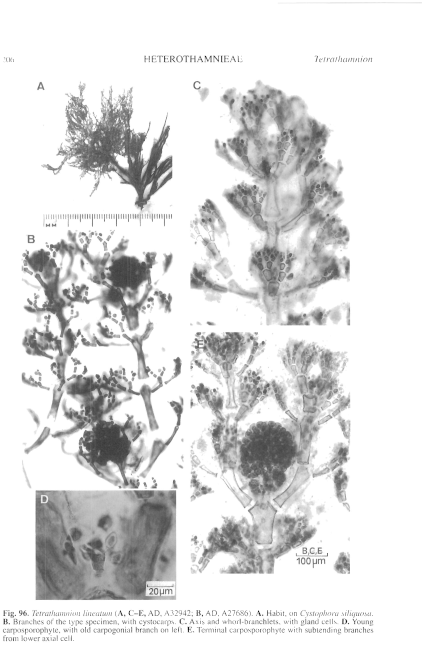|
|
|
|
|
|||||||||||
|
Electronic Flora of South Australia Species Fact Sheet
Phylum Rhodophyta – Order Ceramiales – Family Ceramiaceae – Tribe Heterothamnieae
Synonym
T. pyramidatum Wollaston 1968: 364, fig. 33Q–X. T. ramosum Wollaston 1968: 366, fig. 32P–U.
Thallus (Figs 93 O–U, 96A) 5–50 mm high, often pyramidal in form with erect axes sparsely and distantly branched, each axial cell with 4 more or less horizontal whorl-branchlets (Figs 93P, 96B). Attachment by slender, just-penetrating branched rhizoids (Fig. 93Q) from lower cells of erect axes; epiphytic, mainly on brown algae. Structure. Apical cells 6–8 µm in diameter and L/D 1–1.5, enlarging rapidly to axial cells 70–200 µm in diameter and L/D 3–4, narrower and shorter towards the base. Whorl-branchlets usually separated along the axes, 200–350 µm long with 4–6 successive pseudodichotomies and terminal or upper short chains 2–3 (–4) isodiametric cells long often with a terminal hair; basal cells of whorl-branchlets 20–30 µm in diameter and L/D 2–3, decreasing to 8–12 µm in diameter and L/D 1–1.5 in terminal cells; gland cells (Fig. 93P) usually on subterminal cells of whorl-branchlets, ovoid, 10–16 µm in diameter, touching the bearing and the next upper cell. Lateral branches arising on basal cells of whorl-branchlets, resulting in 3 whorl-branchlets and 1 lateral in a whorl. Cells uninucleate; rhodoplasts discoid to elongate, ribbon like in larger cells.
Reproduction: Gametophytes dioecious. Procarps (Fig. 93R) usually in whorls of 3 just subapically, with a supporting cell bearing a small sterile cell and a 4-celled carpogonial branch, with only one carposporophyte (Fig. 96D, E) developing per whorl; auxiliary cell producing a terminal gonimolobe and 2 lateral, rounded, gonimolobes 100–150 µm across of ovoid carposporangia 30–40 µm in diameter. Carposporophytes (Figs 93S, 96E) terminal, without involucral branches apart from 2–4 extended lateral branches from below. Spermatangial clusters (Fig. 97A, B) formed on small cell branches on upper whorl-branchlet cells, slightly adaxial.
Tetrasporangia (Figs 93T, 97C, D) occur singly on lower cells of whorl-branchlets, sessile, subspherical, 30–50 µm in diameter, tetrahedrally divided.
Type from White Beach, Wedge Bay, Tas., on Sargassum verruculosum, upper sublittoral on reef (Wollaston & Mitchell, 29.ii.1964); holotype in AD, A27686.
Selected specimens: Tiparra reef, Spencer Gulf, S. Aust., on Dictyota, 11 m deep (Shepherd, 13.xii.1971; AD, A41210). Port Noarlunga, S. Aust., on Sargassum, reef pools (Womersley, 6.xi.1960; AD, A24580 - type of T. ramosum, and 11.x.1965; AD, A29614). Aldinga, S. Aust., on Sargassum, reef pools (Skinner, 26.x.1977; AD, A48821). American R. inlet, Kangaroo I., S. Aust., on Sargassum in channel (Womersley, 30.x.1966; AD, A30903). Pennington Bay, Kangaroo I., S. Aust., on Encyothalia, drift (Womersley, 22.viii.1954; AD, A19745 type of T. pyramidatum). Walkerville, Vic., drift (Sinkora A2103, 26.ii.1975; AD, A48167). Coles Bay, E Tas., on Cystophora torulosa, upper sublittoral (Womersley, 19.x.1986; AD, A57478). Stewarts Bay, Port Arthur, Tas., on Caulocystis, drift (Womersley, 30.x.1982; AD, A55786). Green Cape, N.S.W., on Sporochnus, 16 m deep (Shepherd, 13.ii.1973; AD, A43095).
Distribution: Tiparra reef, S. Aust., to Green Cape, N.S.W., and SE Tasmania.
Taxonomic notes: T. lineatum is less densely branched, with longer branches, than T. pyramidatum and T. ramosum, but it is likely (as Athanasiadis 1996, p. 190 suggests) that these two species are only forms of T. lineatum. This species occurs on a variety of hosts, but not on Cystophora siliquosa which is the most common host of Elisiella arbuscula. It occurs under a variety of water movement, with the type and other laxly branched, sheltered water specimens being of the T. lineatum form whereas under stronger water movement specimens are more densely branched as in T. pyramidatum and T. ramosum.
References:
ATHANASIADIS, A. (1996). Morphology and classification of the Ceramioideae (Rhodophyta) based on phylogenetic principles. Opera Botanica No. 128, pp. 1–216.
WOLLASTON, E.M. (1968).Morphology and taxonomy of southern Australian genera of Crouanieae Schmitz (Ceramiaceae, Rhodophyta). Aust. J. Bot. 16, 217–417.
The Marine Benthic Flora of Southern Australia Part IIIC complete list of references.
Publication:
Womersley, H.B.S. (24 December, 1998)
The Marine Benthic Flora of Southern Australia
Rhodophyta. Part IIIC. Ceramiales – Ceramiaceae, Dasyaceae
©State Herbarium of South Australia, Government of South Australia
Illustrations in Womersley Part IIIA, 1998: FIGS 93 O–U, 96, 97.

Figure 93 enlarge
Fig. 93.A–G. Elisiella arbuscula (AD, A27009) A. Habit. B. One of 4 whorl-branchlets with gland cells and a young lateral on the basal cell. C. Gland cell on outer cells of a whorl-branchlet. D. Carpogonial branch (on right) and just post-fertilization stage (on left) near axial apex. E. A carposporophyte. F. A spermatangial cluster on a lower cell of a whorl-branchlet. G. Tetrasporangia on a special adaxial branch on basal cell of a whorl-branchlet. H–N. Elisiella dispar (AD, uncertain). H. Habit, with a prostrate axis bearing erect axes. I. Attachment rhizoids arising from the basal cell of a whorl-branchlet. J. A whorl-branchlet bearing gland cells. K. Part of a whorl-branchlet with a gland cell. L. Carpogonial branch on basal cell of a 2-celled branchlet. M. A mature carposporophyte. N. Tetrasporangia borne on special branches of short cells. O–U. Tetrathamnion lineatum (O–T, AD, A27686). O. Habit. P. Axial apex with young whorl-branchlets with gland cells. Q. Attachment rhizoids from basal axial cells. R. Axial apex with carpogonial branches on basal cells of whorl-branchlets. S. Mature carposporophyte with young gonimolobes. T. Whorl-branchlet with tetrasporangia. U. Habit of densely branched form (T. ramosum). (All as in Wollaston 1968, courtesy of Aust. J. Bot.)

Figure 96 enlarge
Fig. 96. Tetrathamnion lineatum (A, C–E, AD, A32942; B, AD, A27686). A. Habit, on Cystophora siliquosa. B. Branches of the type specimen, with cystocarps. C. Axis and whorl-branchlets, with gland cells. D. Young carposporophyte, with old carpogonial branch on left. E. Terminal carposporophyte with subtending branches from lower axial cell.

Figure 97 enlarge
Fig. 97. Tetrathamnion lineatum (A, AD, A32942; B–D, AD, A64598). A. Axis and whorl-branchlets with spermatangial clusters. B. Adaxial spermatangial clusters on whorl-branchlets. C. Whorl-branchlets with tetrasporangia. D. Tetrahedrally divided tetrasporangia on whorl-branchlets.

|
Email Contact: State Herbarium of South Australia |

|